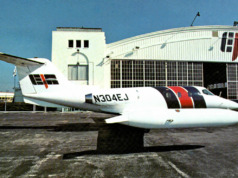
A small red number just popped up over the “App Store” button on my smart phone, indicating that one or more of my apps needs updating – or maybe it’s the phone’s entire operating system. Developers, it seems, have figured out yet another improvement to my near instantaneous worldwide access to people, information … and, of course, to shopping.
These updates invariably offer increased speed and stability, because that quest for communications speed drives all 2.5 billion of the world’s smartphone users. That number is cited by the Global System for Mobile Communications Association, and it represents more than twenty percent of the world’s population.
That need for speed drives business aircraft users as well, though the “app” updates don’t come quite as frequently. It took almost 50 years for business aviation to move from piston to turboprop to turbojet and turbofan-powered aircraft. The flight from New York to Paris that took Lindbergh 33.5 hours to complete? Today’s business jets fly it routinely in fewer than six hours, and have done so for more than 40 years.
But that’s not fast enough. From 1976 to 2003, the Concorde SST made that same flight in 3.5 hours. That’s a little more than a tenth of Lindbergh’s record flight time, available to commercial airline travelers willing to pay the $24,000 per person round trip fare. Unlike smartphone apps, the upgrades and improvements in the speed and reliability of flight are not free.
Our need for speed now has inspired several companies to pursue development of business jet SSTs. Reno-based Aerion, whose AS2 jet is projected to fly for the first time in 2023, was just joined by Boeing in development, and fractional operator Flexjet has committed to purchasing 20 aircraft. Spike Aerospace projects its S-512 SST also will fly in 2023. Boom Technology targets 2021 for test flights of its Overture commercial airliner, with orders in hand from Virgin Atlantic and Japan Air Lines – which also will be available in business jet interior configurations.
Now a nine-figure business jet may seem extravagant, but so did six figures for a bizjet in 1964. The retail price on a new Lear Jet 23 back then was about $500,000: unheard of for an aircraft at the time.
We’ve become spoiled these past 20 years, as communications and data manipulation via PDAs, tablets, smartphones, and apps keep getting faster and faster and more reliable, saving you more and more time.
But you can’t “save” time; you can only reallocate it into more productive uses. And that is the real value of the new, improved, or upgraded business aircraft, whether subsonic or supersonic, transcontinental, or intercontinental. Whether asked in 1964, 2019, or 2023, the question that using business aircraft answers remains the same: What is your time worth?
Publisher of Business Aviation Advisor, has nearly 50 years in business aviation including executive positions at aircraft management/charter and ground services companies. He is a past director of the NATA and Corporate Angel Network.





